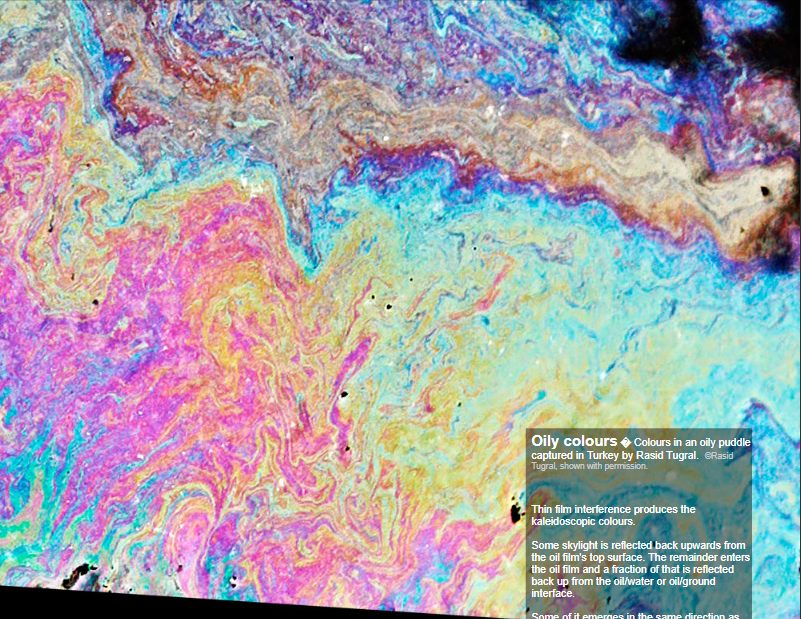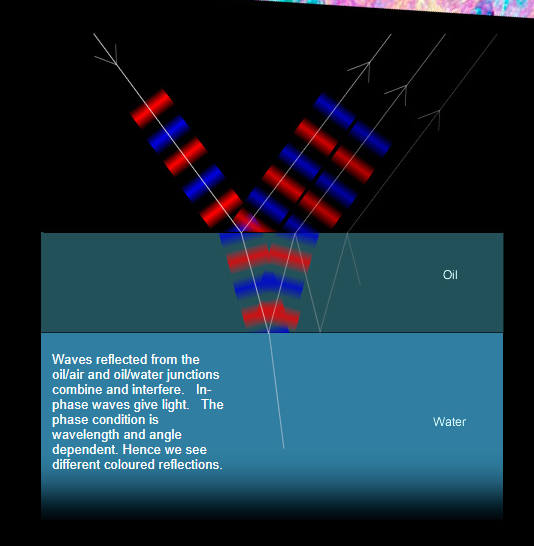Oily colours
Oily Colours: Exploring the Phenomenon of Thin Film Interference
Have you ever marveled at the mesmerizing colors that appear on the surface of an oily puddle or a soap bubble? These vibrant hues are the result of a fascinating optical phenomenon known as thin film interference. In this article, we will delve deeper into the science behind these "oily colors" and uncover the intricate workings of this captivating display.
Understanding Thin Film Interference
Thin film interference occurs when light waves reflect and interact within a thin film of a substance, such as oil or soap. As skylight strikes the top surface of the film, some of it is reflected back upwards, while the rest enters the film. A fraction of the light that enters the film is then reflected back up from the interface between the oil and either water or the ground.
When these two outgoing waves combine, they can either reinforce each other or cancel each other out, depending on their relative phase. If the wave crests coincide, we observe a bright reflection. Conversely, if the waves are out of phase, destructive interference occurs, resulting in no reflection being seen.
The Role of Viewing Angle, Film Thickness, and Refractive Index
The appearance of the colorful reflections is influenced by several factors. Firstly, the viewing angle plays a crucial role in determining the phase relationship between the two waves. As we change our perspective, the relative alignment of the wave crests shifts, altering the interference pattern and consequently modifying the observed colors.
Additionally, the thickness of the film and the refractive index of the oil also contribute to the phenomenon. Thicker films produce different interference patterns compared to thinner ones. Moreover, oils with varying refractive indices can create distinct sets of colors due to their impact on the phase relationship between the waves.
The Intricacies of Wavelength Dependency
One intriguing aspect of thin film interference is its dependence on the wavelength of light. Different wavelengths correspond to different colors, and as a result, we observe a variety of hues in the reflections. This wavelength dependency adds to the wavy and rapidly changing nature of the colors, further enhancing their visual allure.
Exploring the Complexities of Oily Films
The intricate patterns and ever-shifting colors displayed by oily films suggest that the film's surface is uneven. This unevenness introduces variations in the thickness of the film, leading to diverse interference patterns and an array of colors. The interplay between light waves within these macroscopic films creates a visually stunning display reminiscent of iridescent clouds.
Comparing Thin Film Interference to Iridescent Clouds
While both thin film interference and iridescent clouds arise from the interaction of light waves, there are distinct differences between these phenomena. Iridescent cloud colors stem from the scattering of light by individual droplets, whereas film colors depend on interactions within the larger film structure. These variations in the underlying mechanisms give rise to unique visual characteristics in each phenomenon.
Conclusion
The captivating "oily colors" that grace the surfaces of oil puddles and soap bubbles are a testament to the mesmerizing world of atmospheric optics. Thin film interference, with its intricate interplay of light waves within a film, produces a kaleidoscope of vibrant hues that never fail to captivate our senses. By understanding the role of factors such as viewing angle, film thickness, refractive index, and wavelength dependency, we gain insight into the complexities behind this awe-inspiring display. So next time you encounter a shimmering oil slick or a glistening soap bubble, take a moment to appreciate the fascinating science that brings these "oily colors" to life.

Oily colours � Colours in an oily puddle captured in Turkey by Rasid Tugral. ©Rasid Tugral, shown with permission.
Thin film interference produces the kaleidoscopic colours.
Some skylight is reflected back upwards from the oil film's top surface. The remainder enters the oil film and a fraction of that is reflected back up from the oil/water or oil/ground interface.
Some of it emerges in the same direction as that reflected from the upper surface.
The two outgoing waves combine. If their wave crests (shown red for positive and blue for negative at left) coincide we see a bright reflection. When the waves are out of phase there is destructive interference and no reflection is seen.
The relative phase of the two waves depends on the viewing angle, the film thickness and the oil refractive index.
More importantly, the phase is also wavelength dependent. This gives us the coloured reflections.
The wavy and quickly changing colours suggest that the oil film was uneven.
Oil film and soap bubble colours look similar to those of iridescent clouds. Both are produced by interference between light waves but there the similarity ends for cloud colours arise from scattering by individual droplets whereas film colours depend on interactions within the macroscopic film.

Waves reflected from the oil/air and oil/water junctions combine and interfere. In-phase waves give light. The phase condition is wavelength and angle dependent. Hence we see different coloured reflections.
Note: this article has been automatically converted from the old site and may not appear as intended. You can find the original article here.
Reference Atmospheric Optics
If you use any of the definitions, information, or data presented on Atmospheric Optics, please copy the link or reference below to properly credit us as the reference source. Thank you!
-
<a href="https://atoptics.co.uk/blog/oily-colours/">Oily colours</a>
-
"Oily colours". Atmospheric Optics. Accessed on December 22, 2024. https://atoptics.co.uk/blog/oily-colours/.
-
"Oily colours". Atmospheric Optics, https://atoptics.co.uk/blog/oily-colours/. Accessed 22 December, 2024
-
Oily colours. Atmospheric Optics. Retrieved from https://atoptics.co.uk/blog/oily-colours/.